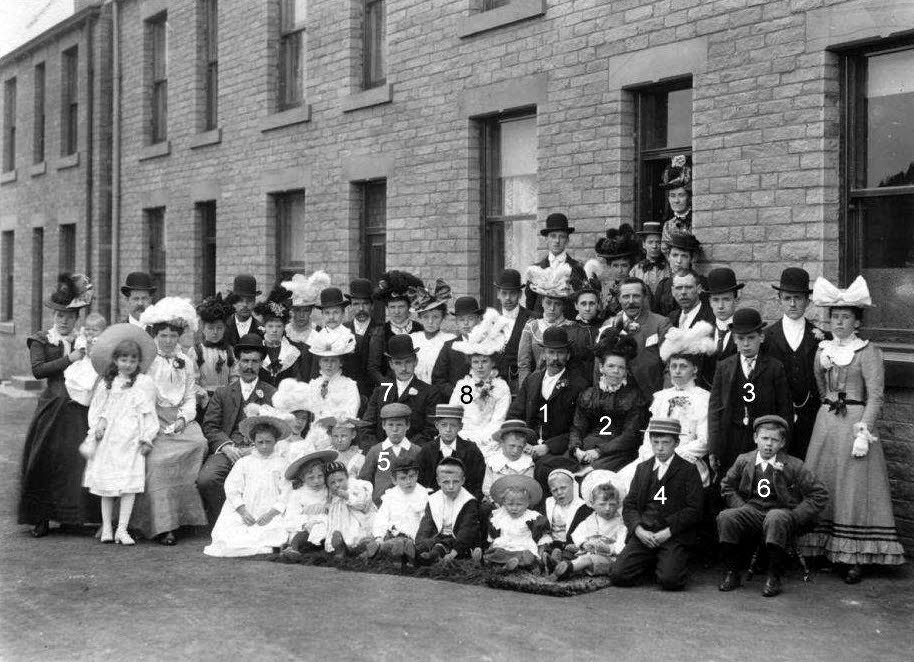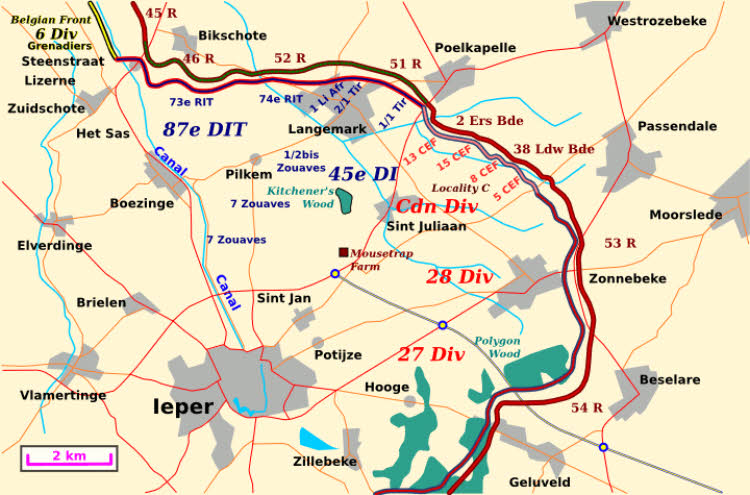
3/3247, York and Lancaster Regiment, 1st Battalion
William Rollinson was born in Ossett in late 1872, the third son and youngest child of five children born to Huddersfield born coal miner Robert Rollinson and his wife, Hannah (nee Lawrenson) who married at Thornhill St. Michael’s Church on Christmas Day 1856. Two of the children died before 1906. Sadly, William’s father Robert Rollinson senior died in 1877 aged 47 and his wife, Hannah, died the following year aged 43, leaving five children, aged between four and twenty years, orphaned.
In 1881, William, aged 9, was living on Ryecroft Street, Ossett with his married brother, James, aged 23, and his wife and child. Also living in the household were William and James’s siblings Alice, aged 14, and Alfred, aged 13. By 1901, James’s growing family had moved to Dale Street, Ossett. William, now aged 17, was working as a coal miner and still living with his brother and family.

Above: The only known picture of William Rollinson at his wedding to Esther Ann Benson in 1898. William Rollinson is number 7 and his new wife, Esther is number 8. One other person identified in the picture is number 6, Robert Rollinson, whom a few years later was killed at Old Roundwood colliery, Ossett in a pit accident. Thanks to Paul Edwards for this picture via Ossett Through the Ages on Facebook.
William Rollinson married widow Esther Ann Benson (formerly Raynor) in Spring 1898 and in 1901 the couple and a 14 year old stepson, William Raynor, were living on Chancery Lane, Ossett. In late February 1906, William Rollinson of Ossett was found guilty of non-payment of a debt. He was 34 years of age, a miner and 5’ 5” tall with brown hair. He received a sentence 10 days in prison or a fine of 14/9d.
More tragedy struck the family when his wife, Esther, died in 1908. William Rollinson appears to have moved to Hunslet by 1911, where he was working as a coal miner, aged 38 years, but it is known that he was living at Gunson Row, Ossett at the time he enlisted in the army to serve in WW1.
William Rollinson was 41 years and 109 days old and a coal miner when, on the 17th August 1914, he became one of the first Ossett men to volunteer. He enlisted at Dewsbury to serve for one year with the colours. William had previously served, before WW1, with the King’s Own Rifle Corps. He was 5’ 6” tall, weighed 125 lbs with a chest measurement of 36½ inches, a fair complexion, blue eyes and fair hair. He was declared fit for the Army and joined the 1st Battalion, York and Lancaster Regiment with the regimental service number 3/3247 and was posted to Special Reserve.
Private William Rollinson embarked for France on the 7th March 1915 and was killed in action six weeks later on the 23rd April 1915. His service record indicates that he was wounded and missing presumed dead in Belgium, and subsequently his body was found and buried in the field. He was posthumously awarded the British and Victory medals and also the 1914/15 Star in recognition of his service overseas before 31st December 1915.
The 1st Battalion, York and Lancaster Regiment returned from Jubbulpore, India on the 23rd December 1914. They moved to Hursley Park and formed within the new regular 28th Division for service in France and Belgium. On the 17th January 1915 they landed at Le Havre. The battalion fought in many of the battles in 1915 being first located in the area between Bailleul and Hazebrouck. They suffered heavy casualties during the Battles of Ypres and Loos. In late 1915 the 28th Division was shipped to Salonika as part of the new British Salonika Army that was created to stop Bulgarian expansion in the Balkans. The battalion spent the rest of the war there suffering one killed in action to every three killed from malaria and dysentery.
Private William Rollinson was killed during the second Battle of Ypres, fought between 21st April and 25th May 1915. On the 23rd April 1915, the 2nd Buffs and 3rd Middlesex were holding the line at the cross roads in the centre of Sint Jan, were joined by the 5th Kings Own and the 1st York and Lancs, to form the Geddes Detachment under the command of Col Geddes of the Buffs. They joined with the Canadian Division to fill the gap left by the French Colonials who had fled under a gas attack the previous evening. Some of the men were used to guard the Yser bridge near Brielen. Later in the day the Geddes Detachment was reinforced and the seven battalions counter-attacked as part of a wider effort to stabilise the line.
“The 1st York and Lancaster made progress from the area of La Belle Alliance, a farm on the western flank of Hill Top Ridge, and as it did so came under very heavy rifle and machine-gun fire. Using all available cover, the battalion made every effort to continue the advance by moving one platoon forward at a time and avoiding exposing any one company to the hail of bullets. However, the scant cover of the hedges and such like was insufficient to allow the battalion to gain much ground, and as they emerged into the open, they suffered heavily from shell and small arms fire. During the first rush over open ground many officers and senior NCOs were killed or wounded, but the remainder pressed on until they had lost so heavily that to have continued the assault would have resulted in complete destruction of the battalion. As it was, Lieutenant-Colonel A.G. Burt and his adjutant, Captain E.S. Bamford were killed and another dozen officers were wounded, whilst the casualties amongst the other ranks amounted to some 400 killed or wounded. The remains of the battalion had to be satisfied with holding the forward position it had reached until it was safe to withdraw, and with the deployment of their machine guns in relatively safe positions some 1,000 yards from the enemy where they were able to bring harassing fire to bear and provide some much needed support.” 1
William’s next of kin was his brother James Rollinson and his sister, Mary Bragan (nee Rollinson) who had married William Bragan in late 1881. In correspondence from the War Office in the years following William’s death, James Rollinson’s addresses were variously given as Littlefield; 4, Audrey Street and 9, New Street, all in Ossett. Mary Bragan’s addresses were given as 21, Springstone Avenue, Ossett and 27 South Parade, Ossett.
William Rollinson is not remembered on any Ossett Memorial or Roll of Honour. He lived in Ossett at the time of enlistment and his brother and married sister also lived in Ossett before and after WW1. In these circumstances it might be expected that he would be remembered on one of the local Memorials or Rolls. He is remembered in this 2014 biography and Roll of Honour because the Commonwealth War Graves Commission and/or the “U.K. Soldiers who Died in the Great War 1914-1918” listing records him as born or residing in Ossett.

Above: The Front Line at Ypres on the 21st April 1915 showing the position of 28 Division.
Private William Rollinson brother of Mr. J. Rollinson, of 7 Littlefield Rd., Ossett. Yorks., died aged 40 years, on the 23rd April 1915 and is remembered on Panels 36 and 55 at the Ypres (Menin Gate) Memorial,2 Ieper, West-Vlaanderen, Belgium. Ypres (now Ieper) is a town in the Province of West Flanders. The Memorial is situated at the eastern side of the town on the road to Menin (Menen) and Courtrai (Kortrijk).
The Menin Gate is one of four memorials to the missing in Belgian Flanders which cover the area known as the Ypres Salient. Broadly speaking, the Salient stretched from Langemarck in the north to the northern edge in Ploegsteert Wood in the south, but it varied in area and shape throughout the war.
The Salient was formed during the First Battle of Ypres in October and November 1914, when a small British Expeditionary Force succeeded in securing the town before the onset of winter, pushing the German forces back to the Passchendaele Ridge. The Second Battle of Ypres began in April 1915 when the Germans released poison gas into the Allied lines north of Ypres. This was the first time gas had been used by either side and the violence of the attack forced an Allied withdrawal and a shortening of the line of defence.
There was little more significant activity on this front until 1917, when in the Third Battle of Ypres an offensive was mounted by Commonwealth forces to divert German attention from a weakened French front further south. The initial attempt in June to dislodge the Germans from the Messines Ridge was a complete success, but the main assault north-eastward, which began at the end of July, quickly became a dogged struggle against determined opposition and the rapidly deteriorating weather. The campaign finally came to a close in November with the capture of Passchendaele.
The German offensive of March 1918 met with some initial success, but was eventually checked and repulsed in a combined effort by the Allies in September.
The battles of the Ypres Salient claimed many lives on both sides and it quickly became clear that the commemoration of members of the Commonwealth forces with no known grave would have to be divided between several different sites.
The site of the Menin Gate was chosen because of the hundreds of thousands of men who passed through it on their way to the battlefields. It commemorates casualties from the forces of Australia, Canada, India, South Africa and United Kingdom who died in the Salient. In the case of United Kingdom casualties, only those prior 16 August 1917 (with some exceptions). United Kingdom and New Zealand servicemen who died after that date are named on the memorial at Tyne Cot, a site which marks the furthest point reached by Commonwealth forces in Belgium until nearly the end of the war. New Zealand casualties that died prior to 16 August 1917 are commemorated on memorials at Buttes New British Cemetery and Messines Ridge British Cemetery.
The Ypres (Menin Gate) Memorial now bears the names of more than 54,000 officers and men whose graves are not known.
References:
1. “Magnificent But Not War: The Battle for Ypres, 1915”, by John Dixon, Pen and Sword Books 2003, ISBN 978 1 84415 890 4